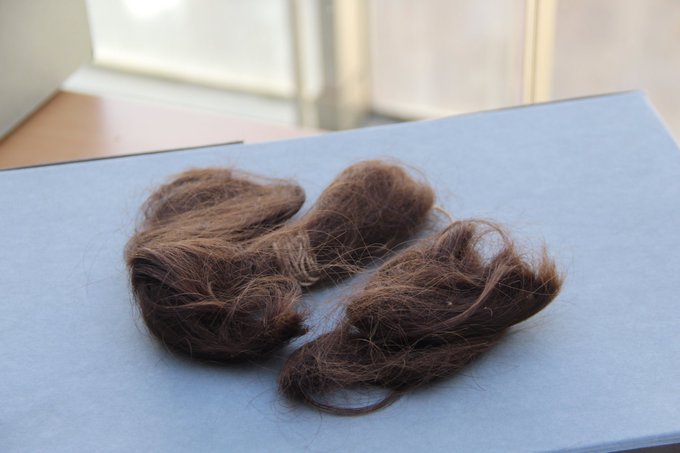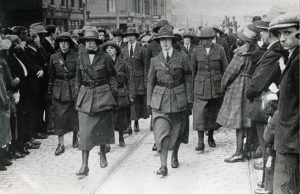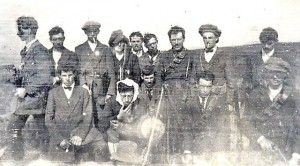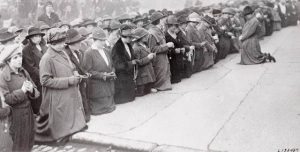Hair Cutting and Women in the War of Independence

By Margaret Ward
As a result of the disturbing addition to the War of Independence exhibition at Collins Barracks of the remnants of a woman’s hair, taken forcibly from her by republican men determined to prevent women from consorting with enemy forces, there has been considerable discussion on the impact of war upon the lives of women.
Much more is now known about the roles played by women as combatants, far less is known about the victims of war – particularly the women who were terrorised by men from both republican and loyalist forces.
Some were attacked because of their republican activities while others were assaulted because they were considered unpatriotic by consorting with members of the police or army. As Linda Connolly writes, ‘Women’s hair…served as a site of symbolic power that could be transgressed and abused by all sides in the conflict.’[1]
Much more is now known about the roles played by women as combatants in the War of Independence, far less is known about the victims of war.
As the decade of commemoration now moves into more problematic years it is essential that the violence and humiliation women suffered is acknowledged. There must be a determination to uncover all truths, not only to do justice to the suffering of the past, but also as a way of gaining greater understanding of our present.
Vivid Personal Memories

Archival evidence from the Bureau of Military History, coupled with applications for war service pensions from members of Cumann na mBan and the IRA, provide us with vivid personal memories regarding those turbulent years.
However, in coming from those involved as combatants on the Irish side their focus, for obvious reasons, has concerned the violence perpetrated by the British.
As Elizabeth Bloxham, a Cumann na mBan founder member and former suffragist, recalled in her witness statement: “These were the days when girls were roughly searched and had their hair cut off by British soldiers”.[2]
Recollections of Cumman na mBan women focus on the violence perpetrated by the British, but republicans were also perpetrators.
That has been the dominant narrative. But we now also have the admission of IRA members that this activity was also practiced from their side, although the violence of the act was grossly downplayed. The term ‘bobbing’, commonly used to describe this practice, underestimates the violence and trauma experienced by the women. Leo Buckley, of the Cork no 1 Brigade, IRA testified:
‘I remember at the time, young girls from Cork going out to Ballincollig to meet the British soldiers. We curbed this by bobbing the hair of persistent offenders. Short hair was completely out of fashion at the period and the appearance of a girl with ‘bobbed’ hair clearly denoted her way of life.’ [3]
Press reports

Research into gender-based and sexual violence experienced by women in the Irish revolutionary period is an area that remains deeply sensitive and under-researched.
New evidence has been uncovered by a number of academics, whose researches are helping to transform the depiction of the war of independence through the inclusion of women’s experiences as victims of violence from both Republican and Crown forces.[4]
This short article focuses only on examples of hair cutting that were reported in the press during 1920 as a means of examining the extent to which such incidents were reported; whether reports included actions from both Republican and Crown forces; and if so, to determine whether people at the time were aware of such practices. Difficult issues of rape, enforced pregnancy and mental illness are now coming to the fore, but they are outside the scope of this discussion.
A search for the phrase ‘hair cutting’ in Irish regional newspapers for the year 1920 yields 20 results. One of these is an advertisement for a hair cutting machine ‘shaped like a razor’ that, ironically, would enable hair cutting to take place at home.
The impersonal tone of press reporting of forced hair cutting fails to convey the trauma created by such assaults.
The other results all consisted of brutal attacks upon women, with, in one unusual instance, male perpetrators attacked in retaliation. Some cases were reported more than once. In total, there were seven cases of women having their hair shorn by republicans, either because they were seen with soldiers or because they had policemen as boyfriends. The impersonal tone of press reporting fails to convey the trauma created by such assaults.
The courts were not the republican courts set up by Dáil Eireann but the court system of the British administration. The treatment of the women varied. In the case of Kate Costello, former servant of the Reverend Martin of Drumshambo, whose hair was cut ‘to deter her from association with his Majesty’s forces’ the men were acquitted as it was deemed her evidence regarding identification was inadequate, despite hair clippers being found in the cupboard of one of the accused.[5]
In the case of Bridget Keegan, four perpetrators were given six months with hard labour, the harshest penalty possible, having been part of a gang of 7 men who, with blackened faces, one with a revolver, had dragged the young women from her bed in the middle of the night, cutting off her hair with a shears, threatening to cut off her ears as they proclaimed they were ‘out for Ireland free’. They were released on bail pending an appeal.[6]
Annie Divine of Tuam was also accosted by men who entered her house while she was in bed. They produced a letter that had been intercepted in the mail, written to her from a constable who had joined the RIC two years previously and with whom she had been intimate before he left the district.
Men in Tuam entered the home of Annie Divine, and told her grandmother: ‘We will make Irish girls have nothing to do with Ireland’s sworn enemies’ before cutting off her hair with shears and a cutting machine.
In response to the pleas from her grandmother the men said: ‘We will make Irish girls have nothing to do with Ireland’s sworn enemies.’Her hair was cut off with a shears and then finished with a hair cutting machine.[7]
When two young women in Dublin walking out with soldiers were accosted by men with revolvers, the men were not charged with assaulting the women, only with possession of revolvers. One woman ran away and the other had her hair cut with a penknife. The former’s evidence was ignored and the latter was dismissed, strangely, as being in sympathy with Sinn Féin. Strong alibis were presented in the men’s defence.[8]
There was one case of a Cumann na mBan member, Babe Hogan, secretary of the Milltown-Malbay branch, being attacked by men in uniform. Hogan, as an experienced activist, resisted her attackers, tearing off the mask of one man, then running out of the back of her house before being accosted by the men and returned to the house.
It was reported that only some of her hair was cut before the scissors ‘fell from the hand of the men who held it.’ She jumped over the back wall of her house and stayed in the adjacent yard overnight. There was also a brief mention of a girl in Ballinasloe who had been attacked, as a party of armed men (presumably republicans) acted in reprisal with one man having his hair shorn off with a horse clipping machine before being released and ‘wildest rumours’ regarding the fate of the other man circulated.[9]
We can never know how many women were subjected to such assaults. Most would not come to the attention of the courts, particularly as there was often little sympathy for those who consorted with ‘the enemy’, and most women would not have wished to draw attention to themselves in such circumstances.
Why were more republican attacks upon women reported? Was this attributable to press bias? Did republican violence escalate as the war became increasingly violent?
‘Haircutting outrages’

The suffrage paper the Irish Citizen, taking a strong feminist line in its condemnation of all violence perpetrated on women, suggested in its editorial on ‘Haircutting Outrages’ that such gender-based violence had until then been exclusively linked to Crown forces:
‘If the “Black and Tans” or their agents indulge in the practice of “Reprisals” by cutting off the hair of girl Sinn Feiners we trust that there will be no counter-cutting of loyalist hair. The practice of cutting off the hair of terrified girls is not one to commend itself to any decent citizen of the Republic; it is base and cowardly as well as futile and degrading…Even a state of guerrilla warfare enjoins decencies at least upon those fighting in the righteous fight.’[10]
While the Irish Citizen urged republicans not to retaliate, Hanna Sheehy Skeffington, editor of the Citizen, and at this time a prominent member of Sinn Féin, wrote to the newspapers regarding the ‘atrocities’ perpetrated by the Army of Occupation, believing that they would continue to have a ‘monopoly’ of such acts. She noted that Sinn Féin police had arrested ‘certain hooligans who recently committed a similar barbarity upon a woman.
Hanna Sheehy Skeffington urged republican police to arrest ‘hooligans’ who had assaulted women by cutting off their hair
The criminals, being arrested and found guilty by a Republican court, were deported.’ She believed the only attacks made upon women by men who were not part of the Crown forces were those committed by ‘agents-provocateurs who infest the country, whose object is to provoke and infuriate the people.’
Many republicans who participated in the war were motivated by an idealism that made it difficult to recognise brutality from their side. Sheehy Skeffington ended by quoting Terence McSwiney’s words ‘victory would be not with those who can inflict most suffering but with those who can most endure.’ [11]
When compiling a ‘Statement of Atrocities on Women in Ireland’ that had taken place around this period, Sheehy Skeffington itemised arrests, raids, searches, assaults, attempted and actual rape, although recognising the difficulty with verifying cases as victims were ‘ashamed and terrified.’[12] All were victims of Crown forces. For those living in those times, where the propaganda war was also an important weapon, it seemed no other victims could be mentioned.

As the different milestones in our Decade of Commemorations are acknowledged, let us remember that while the British imprisoned about 50 women, the Free State government imprisoned around 400 women who had rejected the Treaty settlement. Gender-based violence in the period of the civil war is also a reality.
This is an aspect of the revolutionary years to be investigated and incorporated into a fuller narrative of those times. In so doing we might be able to understand further what happened to women in the formation of the post-revolutionary state, when women were denigrated as furies, blamed for the civil war and measures sanctioned by both main political parties which ensured that they had little choice but to retreat into the home.
Dr Margaret Ward is Hon. Senior Lecturer in History at Queen’s University of Belfast
References
[1] ‘Towards a Further Understanding of the Violence Experienced by Women in the Irish Revolution’, Maynooth University Social Science Institute Working Paper Series no. 7 (Maynooth, January 2019), p.10. Available on-line.
[2] Elizabeth Bloxham, WS632, Military Archives of Ireland.
[3] Leo Buckley, WS174, Military Archives of Ireland.
[4] This useful bibliography has been compiled by Linda Connolly: Lindsay Earner Byrne, “The Rape of Mary M.: A Microhistory of Sexual Violence and Moral Redemption in 1920s Ireland” Journal of the History of Sexuality 24, 1, (2015); Coleman, “Violence against Women During the Irish War of Independence, 1919-21”; Gemma Clarke Everyday Violence in the Irish Civil War (Cambridge, Cambridge University Press, 2014); Justin Dolan Stover, “Families, Vulnerability and Sexual Violence During the Irish revolution,” in Jennifer Evans, and Ciara Meehan (eds.), Perceptions of Pregnancy from the Seventeenth to the Twentieth Century (London, Palgrave Macmillan, 2017), p.59; Julia Eichenberg, “The Dark Side of Independence: Paramilitary Violence in Ireland and Poland after the First World War,” Contemporary European History 19, 3 (2010), pp.231248; Thomas Earls Fitzgerald, ‘…and that created terror’. The dynamics of civilian-combatant interactions in County Kerry, 1918-1923 (Trinity College Dublin, School of Histories and Humanities, HISTORY, 2018); Brian Hughes, Defying the IRA? Intimidation, coercion, and communities during the Irish revolution (Liverpool: Liverpool University Press, 2016); Wilson, Frontiers of Violence.
[5]Leitrim Observer, 6 November 1920.
[6] Tuam Herald, 15 May 1920.
[7] Kerry People, 29 May 1920
[8] Irish Independent, 28 August 1920.
[9] The Liberator (Tralee), 26 October 1920
[10] The Irish Citizen, September-December 1920.
[11] Westmeath Independent 25 September 1920, with thanks to Linda Connolly for this reference.
[12] Margaret Ward, Hanna Sheehy Skeffington: Suffragette and Sinn Feiner, Her Memoirs and Political Writings, UCD Press, 2017, 182-186.